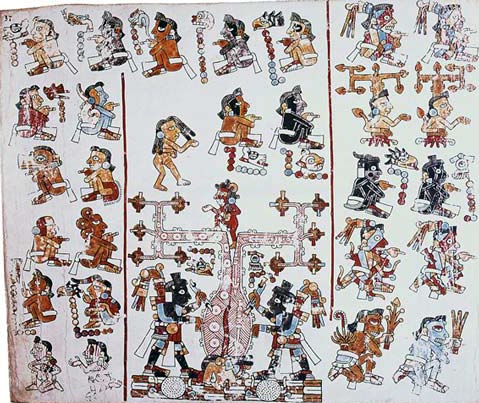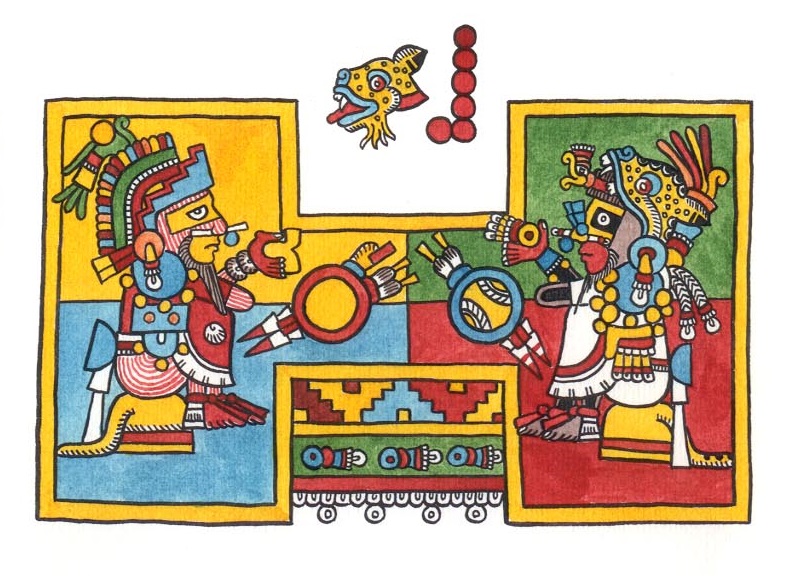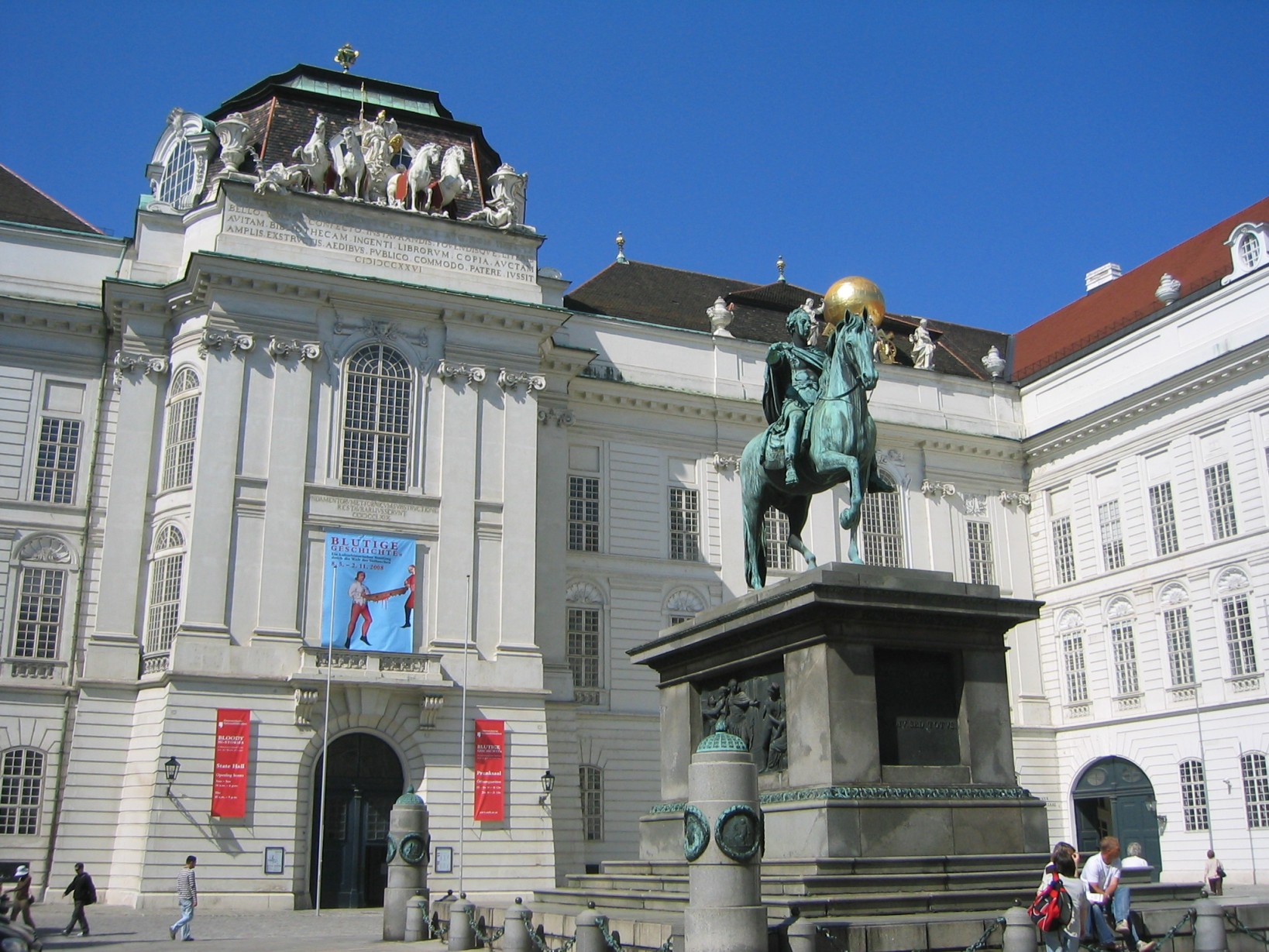|
Codex Vindobonensis Mexicanus I
Codex Vindobonensis Mexicanus I, also known as ''Codex Vindobonensis C'', or ''Codex Mexicanus I'' is an accordion-folded pre-Columbian piece of Mixtec writing. It is a ritual-calendrical and genealogical document dated to the 14th century. Contents Codex Vindobonensis has 52 pages with size 26.5 by 22 cm. It was composed in a form of harmony with length 13.5 m. Its weight is 2.687 kg. The text is divided into 10 major sections. In the beginning it presents mythological genealogies of gods. It also contains lists of Mixtec rulers and priests. History It is not certain where the codex was discovered. It was likely discovered in Veracruz and sent to Sevilla, together with the manuscript Codex Zouche-Nuttall, as a gift for Charles V in 1519. The later story of the codex is not well known, but it traveled to Portugal, Rome, Weimar, and finally Vienna. The manuscript frequently changed owners and places in which it was housed. As a result, its name was changed 18 times ... [...More Info...] [...Related Items...] OR: [Wikipedia] [Google] [Baidu] |
Pre-Columbian
In the history of the Americas, the pre-Columbian era, also known as the pre-contact era, or as the pre-Cabraline era specifically in Brazil, spans from the initial peopling of the Americas in the Upper Paleolithic to the onset of European colonization of the Americas, European colonization, which began with Christopher Columbus's voyage in 1492. This era encompasses the history of Indigenous peoples of the Americas, Indigenous cultures prior to significant European influence, which in some cases did not occur until decades or even centuries after Columbus's arrival. During the pre-Columbian era, many civilizations developed permanent settlements, cities, agricultural practices, civic and monumental architecture, major Earthworks (archaeology), earthworks, and Complex society, complex societal hierarchies. Some of these civilizations had declined by the time of the establishment of the first permanent European colonies, around the late 16th to early 17th centuries, and are know ... [...More Info...] [...Related Items...] OR: [Wikipedia] [Google] [Baidu] |
Mixtec
The Mixtecs (), or Mixtecos, are Indigenous Mesoamerican peoples of Mexico inhabiting the region known as La Mixteca of Oaxaca and Puebla as well as La Montaña Region and Costa Chica of Guerrero, Costa Chica Regions of the state of Guerrero. The Mixtec culture was the main Mixtec civilization, which lasted from around 1500 BCE until being conquered by the Spanish in 1523. The Mixtec region is generally divided into three subregions based on geography: the Mixteca Alta (Upper Mixtec or Ñuu Savi Sukun), the Mixteca Baja (Lower Mixtec or Ñuu I'ni), and the La Mixteca, Mixteca Costa (Coastal Mixtec or Ñuu Andivi). The Alta is drier with higher elevations, while the Baja is lower in elevation, hot but dry, and the Costa is also low in elevation but much more humid and tropical. The Alta has seen the most study by archaeologists, with evidence for human settlement going back to the Archaic period in Mesoamerica, Archaic and Early Mesoamerican chronology#Preclassic Era or Form ... [...More Info...] [...Related Items...] OR: [Wikipedia] [Google] [Baidu] |
Veracruz, Veracruz
Veracruz (), also known as Heroica Veracruz, is a major port city and municipal seat for the surrounding municipality of Veracruz on the Gulf of Mexico and the most populous city in the Mexican state of Veracruz. The city is located along the coast in the central part of the state, southeast of the state capital Xalapa. It is the most populous city in the state of Veracruz. Part of the city extends into the neighboring municipality of Boca del Río. At the 2020 census, Veracruz Municipality had a population of 607,209 inhabitants. The city of Veracruz had a population of 537,952 inhabitants, 405,952 in Veracruz municipality and 132,011 in Boca del Río municipality.2020 census tables: INEGI Developed during Spanish colonization, Veracruz is Mexico's oldest, largest, and historically most significant port. [...More Info...] [...Related Items...] OR: [Wikipedia] [Google] [Baidu] |
Sevilla
Seville ( ; , ) is the capital and largest city of the Spanish autonomous community of Andalusia and the province of Seville. It is situated on the lower reaches of the River Guadalquivir, in the southwest of the Iberian Peninsula. Seville has a municipal population of about 701,000 , and a metropolitan population of about 1.5 million, making it the largest city in Andalusia and the fourth-largest city in Spain. Its old town, with an area of , contains a UNESCO World Heritage Site comprising three buildings: the Alcázar palace complex, the Cathedral and the General Archive of the Indies. The Seville harbour, located about from the Atlantic Ocean, is the only river port in Spain. The capital of Andalusia features hot temperatures in the summer, with daily maximums routinely above in July and August. Seville was founded as the Roman city of . Known as ''Ishbiliyah'' after the Islamic conquest in 711, Seville became the centre of the independent Taifa of Seville foll ... [...More Info...] [...Related Items...] OR: [Wikipedia] [Google] [Baidu] |
Codex Zouche-Nuttall
The Codex Zouche-Nuttall or Codex Tonindeye is an accordion-folded pre-Columbian document of Mixtec pictography, now in the collections of the British Museum. It is one of about 16 manuscripts from Mexico that are entirely pre-Columbian in origin. The codex derives its name from Zelia Nuttall, who first published it in 1902, and Baroness Zouche, its donor. Description The Codex Zouche-Nuttall was probably made in the 14th century and is composed of 47 sections of animal skin with dimensions of 19 cm by 23.5 cm. The codex folds together like a screen and is vividly painted on both sides, and the condition of the document is by and large excellent. It is one of three codices that record the genealogies, alliances and conquests of several 11th and 12th century rulers of a small Mixtec city-state in highland Oaxaca, the Tilantongo kingdom, especially under the leadership of the warrior Lord Eight Deer Jaguar Claw (who died in the early twelfth century at the age of fifty-two ... [...More Info...] [...Related Items...] OR: [Wikipedia] [Google] [Baidu] |
Charles V, Holy Roman Emperor
Charles V (24 February 1500 – 21 September 1558) was Holy Roman Emperor and Archduke of Austria from 1519 to 1556, King of Spain (as Charles I) from 1516 to 1556, and Lord of the Netherlands as titular Duke of Burgundy (as Charles II) from 1506 to 1555. He was heir to and then head of the rising House of Habsburg. His dominions in Europe included the Holy Roman Empire, extending from Germany to northern Italy with rule over the Austrian hereditary lands and Burgundian Low Countries, and Spain with its possessions of the southern Italian kingdoms of Naples, Sicily and Sardinia. In the Americas, he oversaw the continuation of Spanish colonization and a short-lived German colonization. The personal union of the European and American territories he ruled was the first collection of realms labelled " the empire on which the sun never sets". Charles was born in Flanders to Habsburg Archduke Philip the Handsome, son of Maximilian I, Holy Roman Emperor and Mary of Burg ... [...More Info...] [...Related Items...] OR: [Wikipedia] [Google] [Baidu] |
Austrian National Library
The Austrian National Library (, ) is the largest library in Austria, with more than 12 million items in its various collections. The library is located in the Hofburg#Neue Burg, Neue Burg Wing of the Hofburg in Innere Stadt, center of Vienna. Since 2005, some of the collections have been relocated within the Baroque structure of the Palais Mollard-Clary. Founded by the House of Habsburg, Habsburgs, the library was originally called the Imperial Court Library (); the change to the current name occurred in 1920, following the end of the Habsburg Monarchy and the proclamation of the Austrian Republic. The library complex includes four museums, as well as multiple special collections and archives. Middle Ages The institution has its origin in the imperial library of the Middle Ages. During the Medieval period, the Austrian Duke Albert III, Duke of Austria, Albert III (1349–1395) moved the books of the Viennese vaults into a library. Albert also arranged for important works from L ... [...More Info...] [...Related Items...] OR: [Wikipedia] [Google] [Baidu] |
Vienna
Vienna ( ; ; ) is the capital city, capital, List of largest cities in Austria, most populous city, and one of Federal states of Austria, nine federal states of Austria. It is Austria's primate city, with just over two million inhabitants. Its larger metropolitan area has a population of nearly 2.9 million, representing nearly one-third of the country's population. Vienna is the Culture of Austria, cultural, Economy of Austria, economic, and Politics of Austria, political center of the country, the List of cities in the European Union by population within city limits, fifth-largest city by population in the European Union, and the most-populous of the List of cities and towns on the river Danube, cities on the river Danube. The city lies on the eastern edge of the Vienna Woods (''Wienerwald''), the northeasternmost foothills of the Alps, that separate Vienna from the more western parts of Austria, at the transition to the Pannonian Basin. It sits on the Danube, and is ... [...More Info...] [...Related Items...] OR: [Wikipedia] [Google] [Baidu] |
Mixtec Writing
Mixtec writing originated as a logographic writing system during the Post-Classic period in Mesoamerican history. Records of genealogy, historic events, and cultural narratives are found in the pre-Columbian Mixtec codices. The arrival of Europeans in 1520 AD caused changes in form, style, and the function of the Mixtec writings. Today these codices and other Mixtec writings are used as a source of ethnographic, linguistic, and historical information for scholars, and help to preserve the identity of the Mixtec people as migration and globalization introduce new cultural influences. Mixtec history The Mixtec are an indigenous people of Mesoamerica, located in the western region of the modern Mexican states of Oaxaca, eastern part of Guerrero, and southern part of Puebla. The history of the Mixtec people can be traced back to the Formative period, and continues through the Classic and Post-Classic periods to the arrival of Europeans in 1520 AD. Today the region is still populat ... [...More Info...] [...Related Items...] OR: [Wikipedia] [Google] [Baidu] |
Mixtec Group
The Mixtec Group is the designation given by scholars to a number of mostly pre-Columbian documents from the Mixtec people of the state of Oaxaca in the southern part of the Republic of Mexico. They are distinguished by their principally historical and geographical content. Included in the Mixtec Group are: * The Codex Zouche-Nuttall. * The Codex Selden. * The Codex Colombino-Becker. * The Codex Waecker-Gotter. * The Codex Vindobonensis (or Vienna, as it is sometimes called). * The Codex Bodley. See also *Mixtec writing Mixtec writing originated as a logographic writing system during the Post-Classic period in Mesoamerican history. Records of genealogy, historic events, and cultural narratives are found in the pre-Columbian Mixtec codices. The arrival of Europe ... External links Mixtec Group codices [...More Info...] [...Related Items...] OR: [Wikipedia] [Google] [Baidu] |







